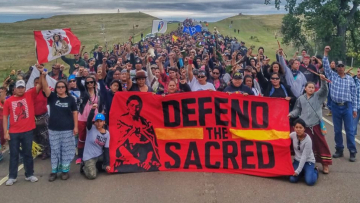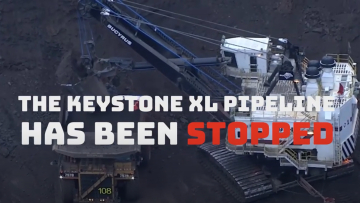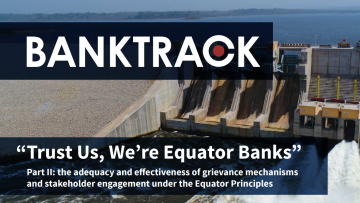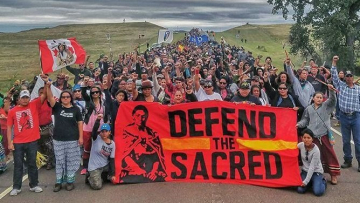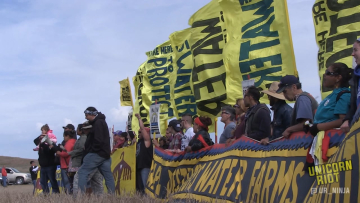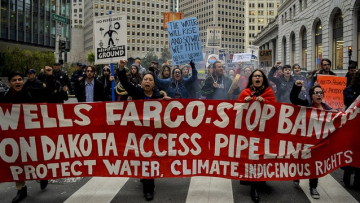Project – On record
This profile is no longer actively maintained, with the information now possibly out of dateJohan Frijns, Director at BankTrack

Project – On record
This profile is no longer actively maintained, with the information now possibly out of dateJohan Frijns, Director at BankTrack
What must happen
Banks must terminate their financing of the Dakota Access Pipeline construction, as well as the financing of the companies behind the pipeline.
| Sectors | Pipeline Transportation of Crude Oil |
| Location |
|
| Status |
Planning
Design
Agreement
Construction
Operation
Closure
Decommission
|
| Website | http://www.daplpipelinefacts.com/ |
|
|
This project has been identified as an Equator Project |
The Dakota Access Pipeline (DAPL) is a 1,172-mile-long underground crude oil pipeline. It is operated by Energy Transfer Partners (38.2%), Enbridge (27.6%), Phillips 66 (25%) and Marathon Petroleum (9.2%). The pipeline begins in the Bakken oil fields in Northwest North Dakota and travels in a more or less straight line south-east, across South Dakota and Iowa, to end at Patoka, Illinois. The pipeline pumps about half a million barrels of oil each day. The oil is sent to the East Coast refineries and other markets by train, or down another 750 miles to the Gulf Coast through a second pipeline.
Impact on human rights and communities
Violation of human rights The pipeline trajectory cuts through Native American sacred territories and unceded Treaty lands, passing within 500 feet of the Sioux reservation. It threatens air and water resources in the region and further downstream. Several sacred sites were bulldozed during construction, according to the Standing Rock Sioux.
In response to peaceful, on-site resistance, police from multiple U.S. states and agencies, members of the U.S. National Guard, and armed private security forces used military equipment, tactics and weapons to intimidate, assault, arrest and otherwise commit grievous human rights violations against water protectors and their allies. Indiscriminate use of attack dogs, rubber bullets, concussion grenades, tazers and mace were reported, while journalists covering the assault were arrested. The violence unleashed by security forces left hundreds severely injured. Police used water cannons in sub-zero temperatures, leading to life threatening situations. Arrested water protectors were subjected to inhumane treatment such as being strip searched and locked in wire cages compared to “dog kennels”.
Indigenous Peoples rights The DAPL project was constructed in clear violation of the rights of Indigenous Peoples, including to Free, Prior and Informed Consent (FPIC). On 27th of July 2016, the Standing Rock Sioux Tribe, represented by Earthjustice, filed a lawsuit against the U.S. Army Corps of Engineers for violating the National Historic Preservation Act and other laws. The complaint says the Corps effectively wrote off the Tribe's concerns and ignored the pipeline's impacts to sacred sites and culturally important landscapes.
In September 2016 the UN Special Rapporteur on the rights of Indigenous peoples called for the project to be halted, saying: “The [Standing Rock Sioux] tribe was denied access to information and excluded from consultations at the planning stage of the project and environmental assessments failed to disclose the presence and proximity of the Standing Rock Sioux Reservation.” An Amnesty International USA spokesperson stated in February 2017 that for the project to be completed "is an unlawful and appalling violation of human rights. The United States is obligated under international law to respect the rights of the Standing Rock Sioux Tribe and all other Indigenous Peoples. To allow this pipeline to go forward without sufficient assessment of how it will impact their land, culture, and access to clean water is a violation of their rights and sovereignty of their land.”
Impact on nature and environment
The Dakota Access Pipeline route crosses sensitive natural areas and wildlife habitat, and involves risks to water resources and animals and their habitats. The route allows the oil company to dig the pipeline under the Missouri River just upstream of the Standing Rock Sioux Tribe’s drinking water supply. See National Geographic's overview of many of these impacts.
Oil spill risks In 2010, a single pipeline spill poured 1,000,000 gallons of toxic bitumen crude oil into the Kalamazoo River in Michigan. The cleanup cost over USD one billion and significant contamination remains. And in January of 2015, more than 50,000 gallons of Bakken crude oil spilled into the Yellowstone River in Montana. It was the second such spill in that area since 2011. Since 2009, the annual number of significant accidents on oil and petroleum pipelines has shot up by almost 60 percent, roughly matching the rise in U.S. crude oil production, according an analysis of federal data by The Associated Press. Nearly two-thirds of the leaks during that time have been linked to corrosion or material, welding and equipment failures, problems often associated with older pipelines, although they also can occur in newer ones, too. Other leaks were blamed on natural disasters or human error, such as a backhoe striking a pipeline. Industry officials and federal regulators say they have adequate means of gauging the safety of pipelines, but the aging infrastructure is a source of lingering concern for outside experts (source The Chicago Tribune).
On August 2, 2016 17 banks signed onto a USD 2.5 billion loan to Dakota Access, LLC and Energy Transfer Crude Oil Company for construction of the Dakota Access Pipeline and the Energy Transfer Crude Oil Pipeline. This loan is expected to make up all the rest of the capital needed to construct the project. Citi, Mizuho, Bank of Tokyo Mitsubishi UFJ and TD Bank are lead banks regarding this loan.
The route of the pipeline, which crosses the Missouri River near the Standing Rock reservation, was agreed in September 2014, according to dates on Public Service Commission documents. (Bismark Tribune).
Update: ABN AMRO, BayernLB, BNP Paribas, DNB, ING and Nordea all announced early 2017 that they will sell their part of the project loan. Please see here for more information.
Next to directly financing the construction of the pipeline through the project finance loan, more banks have also committed substantial resources to the Energy Transfer family of companies so it can build more oil and gas infrastructure. Energy Transfer Partners has a revolving credit line of USD 3.75 billion toward expanding its oil and gas infrastructure holdings, with commitments from 26 banks. Sunoco Logistics has a credit line of USD 2.5 billion in commitments from 24 banks. Energy Transfer Equity (ETE) has a credit line with another USD 1.5 billion in commitments from most of the same big international banks.
On March 24, 2017, ETE signed a new credit agreement of USD 1.5 billion.
Project sponsor
Dakota Access LLC
United StatesOther companies
Applicable norms and standards
Mural at Hammer museum in Los Angeles depicting the financing of DAPL
Protest against DAPL at Wells Fargo, November 10 2016
DAPL Company Levels RICO Charges Against Greenpeace
Keystone XL and Dakota Access pipelines controversy explained
Mni Wiconi: The Stand at Standing Rock
Dakota Access Pipeline Video by Ecowatch
Dakota Access: Standing Rock protesters tell of violent arrests and police abuse
Protest in Montreal on Nov 7 2016, targeting Royal Bank of Canada, TD and Scotiabank for their investments in the DAPL
Dakota Access Pipeline Company attacks Native American protesters with dogs and pepper spray
2020
2020-07-06 00:00:00 | Court scraps Dakota Access Pipeline permit, forcing shutdown
The Dakota Access pipeline must shut down by Aug. 5, a district court ruled Monday in a stunning defeat for the Trump administration and oil industry. The U.S. District Court for the District of Columbia said a crucial federal permit for Dakota Access fell too far short of National Environmental Policy Act requirements to allow the pipeline to continue operating while regulators bolster their analysis. The ruling scraps a critical permit from the Army Corps of Engineers, and requires the pipeline to end its three-year run of delivering oil from North Dakota shale fields to an Illinois oil hub. Judge James E. Boasberg said Dakota Access must shut down the pipeline and empty it of oil by Aug. 5 (Bloomberg Law).
2020-03-26 00:00:00 | Court orders full environmental review for Dakota Access Pipeline
The future of the controversial Dakota Access Pipeline has been thrown into question after a federal court struck down its permits and ordered a comprehensive environmental review. The US army corps of engineers was ordered to conduct a full environmental impact statement (EIS), after the Washington DC court ruled that existing permits violated the National Environmental Policy Act (The Guardian).
2017
2017-06-15 00:00:00 | Dakota Access pipeline: judge rules environmental survey was inadequate
A federal judge has handed a lifeline to efforts to block the Dakota Access pipeline, ruling Wednesday that the US Army Corps of Engineers did not adequately consider the possible impacts of an oil spill where the pipeline passes under the Missouri river. US district judge James Boasberg said in a 91-page decision that the corps failed to take into account how a spill might affect “fishing rights, hunting rights, or environmental justice, or the degree to which the pipeline’s effects are likely to be highly controversial” (source The Guardian).
2017-04-26 00:00:00 | Six banks step away from Dakota Access Pipeline (DAPL) and backers
In February 2017, ABN AMRO, ING, BayernLB and Nordea all announced they would step away from financing the project or its backers. ABN AMRO committed to end its financing for Energy Transfer Equity (ETE) if the pipeline proceeds without consent from the Standing Rock Sioux or with further violence. Nordea excluded three companies behind the Dakota Access Pipeline from investment. BayernLB stated it will withdraw from financing DAPL at the earliest opportunity, and not provide further finance. In March, ING became the first bank to sell its portion of a project loan to the pipeline. A good move followed by DNB (entered into an agreement to sell its part of the loan) and by BNP Paribas (sold its part of the loan in April).
2017-02-08 00:00:00 | Army Corps of Engineers issues easement, construction begun
On February 8, 2017, the U.S. Army Corps of Engineers granted an easement to Dakota Access, LLC allowing the installation of a thirty-inch diameter light crude oil pipeline under Federal lands managed by the Corps at Oahe Reservoir. The granting of this easement follows the February 7th Secretary of the Army decision to terminate the Notice of Intent to Perform an Environmental Impact Statement and notification to Congress of the Army’s intent to grant an easement to Dakota Access for the Lake Oahe crossing.
2017-01-26 00:00:00 | Seven banks—including Wells Fargo, TD Bank, and Citibank—will meet with Standing Rock Sioux leaders after months of intense defund-DAPL pressure
As fierce resistance to the Dakota Access pipeline played out on the North Dakota plains this fall and winter, other activists were putting pressure on the banks financing the pipeline. They called executives, held protests in branches, and moved their money. At least USD52 million has been withdrawn so far, according to organizers. Read more here.
2017-01-24 00:00:00 | Trump criticised on revival of Dakota Access Pipeline
Donald Trump was sharply criticised by Native Americans and climate change activists on Tuesday after he signed executive orders to allow construction of the Dakota Access and Keystone XL oil pipelines. Both pipe projects had been blocked by Barack Obama’s administration, partly because of environmental concerns. But Trump has questioned the science of climate change and campaigned on a promise to expand energy infrastructure and create jobs (source The Guardian).
2016
2016-12-04 00:00:00 | US Army Corps will not grant easement for Dakota Access Pipeline crossing
The Department of the Army will not approve an easement that would allow the proposed Dakota Access Pipeline to cross under Lake Oahe in North Dakota, the Army's Assistant Secretary for Civil Works announced on December 4.
Jo-Ellen Darcy said she based her decision on a need to explore alternate routes for the Dakota Access Pipeline crossing. Darcy said that the consideration of alternative routes would be best accomplished through an Environmental Impact Statement with full public input and analysis (source US Army Corps).
2016-11-25 00:00:00 | ABN AMRO Bank responds on Dakota Access Pipeline
ABN AMRO issued a statement denying involvement in the financing of the Dakota Pipeline, but acknowledged its credit relation with Energy Transfer Equity, the parent company of the project. Find the statement here (in Dutch).
2016-11-17 00:00:00 | Norwegian bank DNB sells it assets in companies building the Dakota Access Pipeline
The largest bank in Norway, DNB, has announced that it has sold its assets in the Dakota Access Pipeline. The assets were USD 3 million worth. DNB recently indicated that it is also reconsidering the loans it provided. In response to the news, Greenpeace Norway Sustainable Finance Campaigner Martin Norman said: “It is great that DNB has sold its assets in the disputed pipeline, and it is a clear signal that it is important that people speak out when injustice is committed. We now expect DNB to also terminate its loans for the project immediately.”
2016-11-07 00:00:00 | Norwegian bank DNB says considering pulling financing on Dakota Access Pipeline
Norwegian bank DNB will reconsider its participation in the financing of the Dakota Access Pipeline if concerns raised by Native American tribes are not addressed, the bank stated on November 6. Local authorities and protesters have been clashing over Energy Transfer Partner's USD 3.8 billion Dakota Access Pipeline project, which would offer the fastest and most direct route to bring shale oil from North Dakota to Illinois. Native American tribes contend that the pipeline would disturb sacred land and pollute waterways supplying nearby homes. "DNB looks with worry at how the situation around the pipeline in North Dakota has developed. The bank will therefore take initiative and use its position to bring about a more constructive process to find a solution to the conflict," Norway's largest bank said in a statement ( source Reuters).
2016-11-02 00:00:00 | ING expresses its concern in financing the Dakota Access Pipeline
ING, being one of 17 banks financing the Dakota Access Pipeline, with an investment of USD 120 million, expresses its concern in the following statement.
2016-09-09 00:00:00 | Joint Statement from the Dep. of Justice, the Dep. of the Army and the Dep. of the Interior Regarding Standing Rock Sioux Tribe v. U.S. Army Corps
The Department of Justice, the Department of the Army and the Department of the Interior issued the following statement regarding Standing Rock Sioux Tribe v. U.S. Army Corps of Engineers: "We appreciate the District Court's opinion on the U.S. Army Corps of Engineers' compliance with the National Historic Preservation Act. However, important issues raised by the Standing Rock Sioux Tribe and other tribal nations and their members regarding the Dakota Access pipeline specifically, and pipeline-related decision-making generally, remain. Therefore, the Department of the Army, the Department of Justice, and the Department of the Interior will take the following steps.
The Army will not authorize constructing the Dakota Access pipeline on Corps land bordering or under Lake Oahe until it can determine whether it will need to reconsider any of its previous decisions regarding the Lake Oahe site under the National Environmental Policy Act (NEPA) or other federal laws. Therefore, construction of the pipeline on Army Corps land bordering or under Lake Oahe will not go forward at this time. The Army will move expeditiously to make this determination, as everyone involved - including the pipeline company and its workers - deserves a clear and timely resolution. In the interim, we request that the pipeline company voluntarily pause all construction activity within 20 miles east or west of Lake Oahe.
2016-07-27 00:00:00 | The Standing Rock Sioux Tribe files their complaint
On July 27th 2016 a complaint was filed by the Standing Rock Sioux Tribe, represented by EarthJustice. The lawsuit challenges the federal government's deeply flawed process for permitting the pipeline. The project is expected to go forward without any comprehensive environmental review or meaningful consultation with the Tribe, as Dakota Access secured the necessary approvals from the U.S. Army Corps of Engineers using a self-service permitting scheme that is urgently in need of reform. Details of the complaint can be found here.

